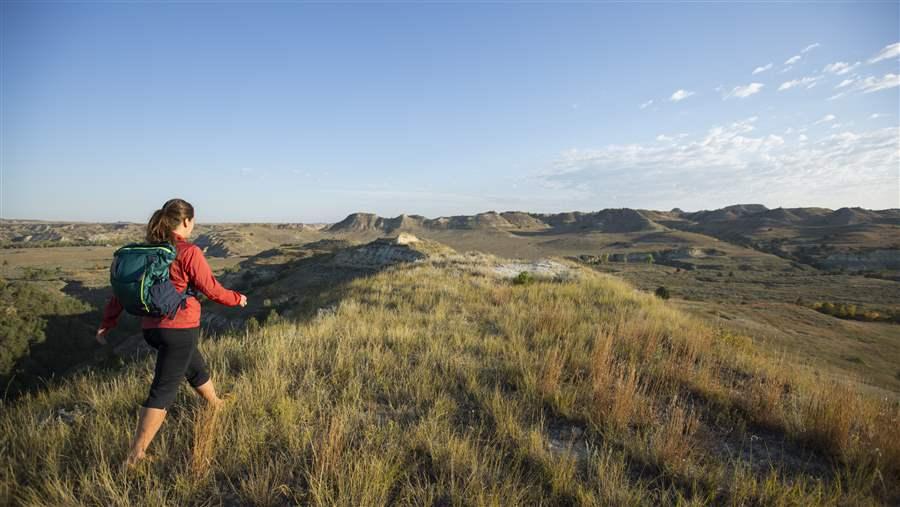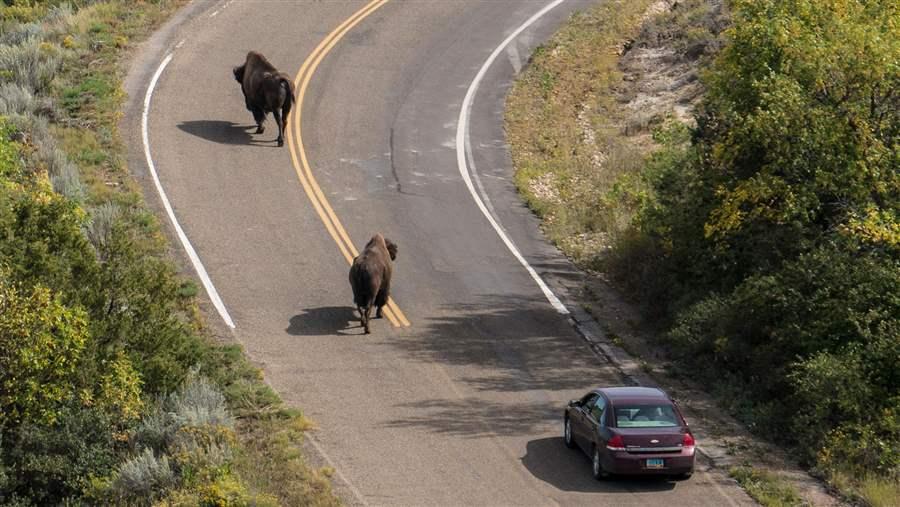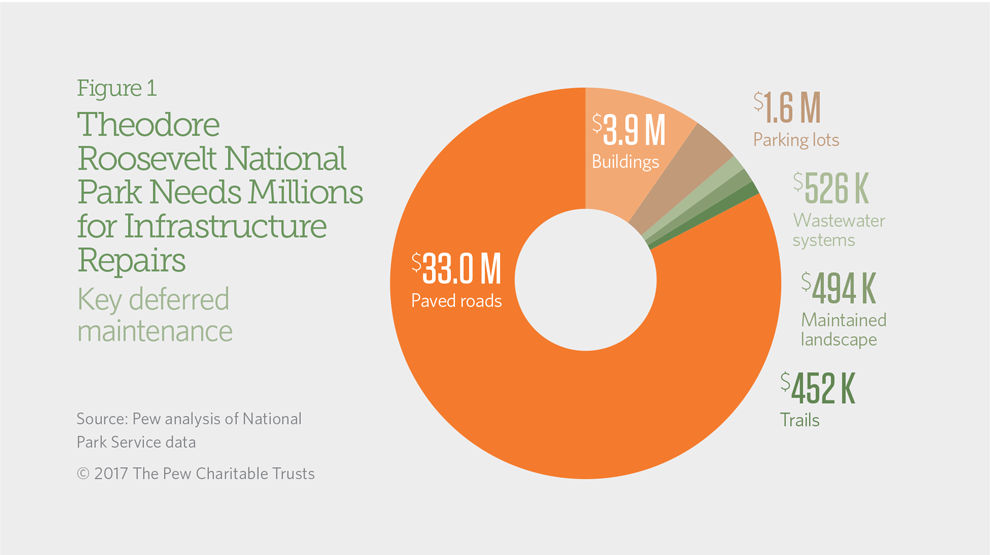Theodore Roosevelt National Park
North Dakota

The New York Times listed the park at No. 5 on its 2016 list of must-see places, with Painted Canyon Overlook providing one of the best places to watch the sun rise over the badlands.
© Aurora PhotosPew created this case study using National Park Service deferred maintenance data issued in fiscal year 2015. The information listed here may no longer reflect the NPS site’s current condition or maintenance requirements. To find the most up-to-date information, please use the National Park Repair Needs tool.
This case study was updated on July 31, 2017, to reflect newly released 2016 data and to correct references to calendar and fiscal year.
Overview
Theodore Roosevelt National Park—encompassing badlands, prairie, and a historic ranch in remote western North Dakota, threaded together by the winding Little Missouri River—draws some 500,000 visitors a year to the rugged landscape that inspired the 26th president to make conservation a cornerstone of his administration. Now the park that bears his name needs an estimated $41 million for repairs to roads, trails, and buildings, according to the National Park Service (NPS).
The New York Times listed the park at No. 5 on its 2016 list of must-see places, with Painted Canyon Overlook providing one of the best places to watch the sun rise over the badlands. A 36-mile scenic drive—and more than a dozen hiking trails—offers other ways to experience the land and see iconic western animals such as bison and prairie dogs. Heavy traffic on these routes and the harsh north country climate, however, have taken a toll on the park’s infrastructure.
Theodore Roosevelt National Park needs over $40 million in repairs, including upkeep on trails and roads.

Theodore Roosevelt National Park needs over $40 million in repairs, including upkeep on trails and roads.
© Dianne Leeth/Alam
Maintenance challenges
One of the first things many visitors see upon entering the park is the visitor center in the North Unit. The facility has significant visible cracks in its foundation that would cost more than half-a-million dollars to repair. Motorists also may experience the park’s deferred maintenance issues firsthand. Although the North Unit’s Loop Road was recently repaired and upgraded, $15 million is needed to fix the South Unit Loop Road, which has numerous potholes and large sections of cracked and chipped seal that have effectively turned the pavement into gravel. Some of the damage stems from severe flooding of the Little Missouri in 2011 that washed out portions of the road. In addition, upgrades are needed for road signage and safety. Some pullouts and overlooks aren’t compliant with the Americans with Disabilities Act (ADA), and lanes and shoulders need to be widened along dangerous stretches.
Nearly every trail in the park also requires attention, with a price tag of just under $500,000. Vegetation needs to be trimmed back to keep trails passable and visible, while tread resurfacing and repairs to signage, steps, and handrails are also necessary to improve visitor safety and prevent further deterioration.
The park’s buildings also need urgent attention. The bill is almost $4 million to repair or replace roofs, lighting, fire and alarm systems, and water and sewer connections. Energy efficiency upgrades such as new heating, air conditioning, and ventilation systems, occupancy sensors, and programmable thermostats are also needed. Upgrades would make bathrooms ADA-compliant. The park also needs more than $1 million to convert the Peaceful Valley Ranch site—one of the first dude ranches in the West to offer horseback tours to visitors—into an environmental education center. The conversion would help educate new generations on the value of carrying forward Theodore Roosevelt’s legacy of conservation.
I do not believe that any man can adequately appreciate the world of to-day unless he has some knowledge of ... [and] some feeling for ... the history of the world of the past.Theodore Roosevelt (1911)
Recommendations
To address the deferred maintenance needs at Theodore Roosevelt National Park and other NPS sites in North Dakota and across the country, Congress should:
- Ensure that infrastructure initiatives include provisions to address park maintenance.
- Provide dedicated annual federal funding for national park repairs.
- Enact innovative policy reforms to ensure that deferred maintenance does not escalate.
- Provide more highway funding for NPS maintenance needs.
- Create more opportunities for public-private collaboration and donations to help restore park infrastructure.
Theodore Roosevelt National Park Facts
2016
|
Visitor spending |
$47.8 million |
|
Jobs created by visitor spending |
654 |
|
Economic output |
$51 million |
|
Labor income |
$17.8 million |
|
Visits |
753,880 |
|
Deferred maintenance (fiscal year 2015) |
$40.8 million |
Sources: National Park Service, “Annual Visitation Reports by Years: 2005 to 2015,” accessed Aug. 25, 2016, <a href="https://irma.nps.gov/Stats/ SSRSReports/National%20Reports/Annual%20Visitation%20By%20Park%20(1979%20-%20Last%20Calendar%20Year)" target="_blank">https://irma.nps.gov/Stats/SSRSReports/National Reports/Annual Visitation By Park (1979 - Last Calendar Year);National Park Service, “Visitor Spending Effects,” accessed Aug. 22, 2016,https://www.nps.gov/subjects/socialscience/vse.htm; National Park Service, “NPSDeferred Maintenance Reports,” accessed Aug. 19, 2016, https://www.nps.gov/subjects/ plandesignconstruct/defermain.htm(Pew converted National Park Service data from this webpage and other NPSsources into a searchable database)
© 2017 The Pew Charitable Trusts
The Pew Charitable Trusts works alongside the National Parks Conservation Association, the National Trust for Historic Preservation, and other national and local groups to ensure that our national park resources are maintained and protected for future generations to enjoy.












